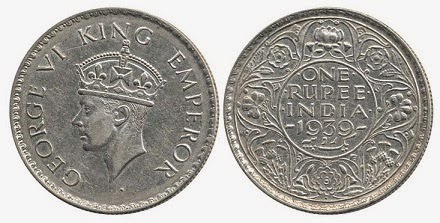The relation between currency and religion
Nishka
Coin Obverse & Reverse (Frog like structure)
Several
researches have confirmed that in ancient times, there was an express relation
between money and religion. Many scholars are of the opinion that gold coins
were issued during the Gupta period with a view to enable the kings carry out
their religious rites that were linked with their position as the Chakravartin.
According to history, the Indian kings of the primeval period had to make huge
donations or payments to the Brahmins who helped them to conduct several
religious rituals and ceremonies such as the ‘Ashwamedha Yagna’ or the horse
sacrifice to establish their supremacy as ‘world rulers’. Moreover, ancient
Indian scriptures such as the Vedas clearly mention that the Brahmins had to be
paid in gold for their services. This is one of the reasons why the Gupta
rulers issued gold coins. Although this was not the only reason for issuing
gold coins during this period, one thing is clear that the gold coinage was in
no way issued to benefit the subjects. Looking back, one will find that the
rulers of northern India hardly made any effort to issue coins for day-to-day
use of the common people. In fact, the copper coins issued in ancient northern
India are rarer than the gold coins, which themselves are always a scarce item.
It may be mentioned here that the account of gold given to the priests
mentioned in the Vedic literature are supposed to be the most basic records
related to use of money made from precious or any other metal in India. And
what is noteworthy about these forms of money is that they were issued mainly
for conducting religious and social functions and were not for commercial or
political use. Although the specific date of the composition of the Vedic texts
is yet to be ascertained, they are commonly believed to have been composed
during the period between latter part of the second millennium and early part
of the first millennium sometimes around the same time when the Iranian
scripture Avesta was composed. The Vedic scriptures endured till the first
millennium A.D. through oral communications down the ages. The Vedic scriptures
as well as the Avesta are said to be an analogous body of manuscripts.
The
mention of gold paid to the Brahmins in the Vedic scriptures is supposed to be
either in a vague form or in the form of an ornament worn around the neck known
as the nishka. According to the Vedic scriptures, the standard payments made by
the kings to the royal priests and poets in gold were anything between 100 and
40,000 nishkas. Apart from the Vedas, even the legal texts of that period ‘Manu
Shashtra’ or the Law of Manu also makes mention of such payments and goes ahead
to detail their assessment vis-à-vis cattle. Incidentally, mentions of making
payments in the valuation of cattle are also found in the Iranian Avesta and in
some initial Greek and Roman scriptures. The kings were entitled to pay the
priests in cattle or nishka or both. Incidentally, it is not possible to verify
these issues through archaeology and even the descriptions provided in the
ancient texts do not throw much light or offer any exactness on their design
and form to enable scholars to identify nishkas from the few samples of gold
jewellery recovered from that period.
Here,
it is pertinent to mention that in the pre-historic period, the nishka
was considered to be a unit of gold and silver currency and it remained in use
for several centuries. Later, the nishka resurfaces with a new name nikkha in
the ‘Jatakas’ - the Buddhist holy scripture that deals with the different
previous incarnations of the Buddha. The Jatakas are believed to have been
compiled between the fourth century B.C. and the first century B.C. Like in the
Gupta era where niskhas were primarily meant for religious and social spending
or making payments to priests and had nothing to do with commercial or
political dealings, the nikkha too is believed to have been used for making
payments to teachers and as ransom sum. According to the Jatakas and other
records available from the period, the nikkha too was not used for any commercial
dealings. According to some scholars, the records maintained in the texts of
these primeval times were somewhat prejudiced and do not present the true
picture of the use of money in ancient India. However, these ancient scripts do
help us to learn about the real significance of non-profitable cultural aspects
in finding out the approaches concerning the utility of money in the Indian
social order, especially in association with issues such as religion and bonds
of societal responsibilities.



